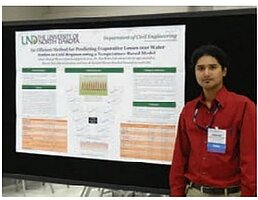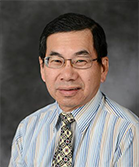Advancing Hydrologic Simulations and Flood Frequency Analysis of Devils Lake under Climate Change Scenarios

Hasin Shahad
Fellow: Hasin Shahad Munna
Adviser: Howe Lim
Advancing Hydrologic Simulations and Flood Frequency Analysis of Devils Lake under Climate Change Scenarios
Progress:
The research focuses in calibrating a coupled rainfall-runoff model and a reservoir model for the Devils Lake using data from both ground gage stations and NASA satellite observations. The purpose is to determine the feasibility of using spatially distributed GCM data with a well calibrated hydro-climatic model to predict the probable flood severities. A temperature-based evaporation prediction model is also developed to simulate the outflow from the terminal lake. Future hydrology of the basin and lake levels of Devils Lake are simulated using the weather samples obtained from several downscaled GCM runs under varying scenarios due to anthropogenic modifications and the resulting composition of the atmosphere. 100 traces of future water levels of the Devils Lake have been generated using the predicted temperature and precipitation by the 12 GCMs. The synthetic traces show a downward trend in water levels for a 30 year simulation period. The annual peak series of the synthetic traces (both stage and volume) are sorted and analyzed to obtain the probabilities and return periods of extreme flood events. The Bulletin 17B recommended LP3 method along with Gaussian/Normal, Lognormal and Gamma/Pearson type 3 distributions are applied for comparison purposes. The Log-Normal probability distribution, in both cases (stage and volume) provided with better fits. Water levels of closed-basin lakes are usually characterized by high serial dependence. The lake is already in its highest peak of the recorded history (1454 ft, spring, 2011), which is set as the base condition for the simulation of future water levels. These circumstances require the probability to be calculated both in a conditional and unconditional basis. Moreover, the probability is calculated both in terms of stage and volume, and probabilities of water levels being 1456, 1458 and 1460 ft have been reported. Considering the stage of the lake, the conditional probabilities are 0.008, 0.003 and .001 percent and the unconditional probabilities are 1.12, 0.44 and 0.189 percent respectively. By converting the stages into volumes, the conditional probabilities are 0.004, 0.002 and 0.0009 percent and the unconditional probabilities are 1.5, 0.68 and 0.31 percent respectively. These lower probability values indicate a lower chance of spilling into the Sheyenne River in the near future based on GCM predictions.
Conference Presentations and Proceedings:
Munna, H.S. (2012, May). “Development of a Temperature-based Model to Simulate Evaporative Losses over Water Bodies in Cold Regions”, World Environmental and Water Resources Congress, ASCE-EWRI, Albuquerque, New Mexico.
Lim, Y. H., Zhang, X., Kirilenko, A., Teng, W. and Munna, H. S. (2012, May). “Flood Frequency Analysis of Devils Lake under Current and Projected Future Climates Utilizing HEC Hydrologic Models, NASA Satellite Observations and Downscaled GCM Simulations”, World Env. and Water Res. Congress, ASCE-EWRI, Albuquerque, New Mexico.
Munna, H.S. and Lim, Y. H. (2012, May). “An Efficient Method for Predicting Evaporative Losses over Water Bodies in Cold Regions using a Temperature-Based Model”, Poster Paper, World Env. and Water Res. Congress, ASCE-EWRI, Albuquerque, New Mexico.
Munna, H.S. and Lim, Y. H. (2010, Dec). “Coupling of HEC-HMS and HECResSim in Modeling the Fluctuation of Water Level in Devils Lake Using Heterogeneous Data”, Poster Paper, Abstract H43F-1324 presented at 2010 Fall Meeting, American Geophysical Union, San Francisco, California.
Seminar Presentation:
“Water Level Quantiles of a Terminal Lake under Future Climate Change Conditions” (2012, April) at the “Terrestrial Water Cycle Seminar”, NASA’s Goddard Space Flight Center, Greenbelt, Maryland.

Lim Yeo Howe
Civil Engineering
Upson Hall II Room 260D
243 Centennial Drive Stop 8115
Grand Forks, ND 58202-8115
Phone: 701-777-3998
Email: yeo.lim@und.edu


